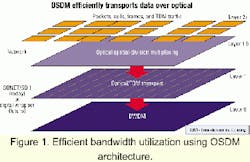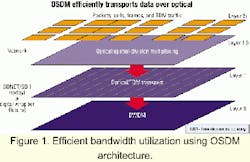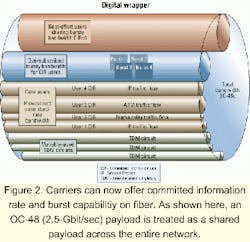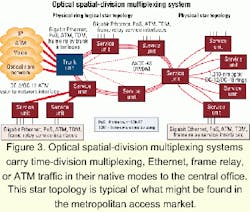New spatial multiplexing architecture keeps fiber networks truckin'
As the metro market seeks its own identity, OSDM can do for the optical network what packet switching did for private line.
HAKIM DHILLA, Coriolis Networks
Truckers figured out long ago that it is more profitable to haul full loads of assorted cargo than to use a different vehicle for each kind of payload. Network engineers at most telecommunications companies feel the same way. Ideally, a well-designed fiber-optic network allows the carrier to haul a mixed lot of voice, time-division multiplexing (TDM), ATM, Ethernet, SONET/SDH, and other services effectively and efficiently. Unfortunately, today's SONET architecture is not designed to be the most efficient transport method for mixed data and voice traffic.
To double the difficulty, the equipment produced for the metropolitan access network rarely is designed for metro access. Typically, the optical components are watered-down versions of DWDM equipment for long-haul applications, metro core components not optimized for the access market, or enterprise products that are unproven as carrier-class equipment. In any case, the jury-rigged solution is not economical. What the metro access market needs is architecture designed for the job at hand-an architecture with capacity, quick restoration, serviceability, and scalability to handle increasing demand. And it should provide it all at an attractive cost per port for all types of voice and data traffic.
The metro area network is where the local and wide area networks meet-where the WAN characteristics of reliability, capacity, scalability, survivability, and bandwidth efficiency have to be married to the LAN characteristics of dynamic provisioning, quality of service (QoS), multiservice support, low cost, and ease of operation. Merely extending the architecture optimized for either LANs or WANs into the metro network will not cut it. What is needed is a new technology that blends-not extends-all these characteristics into one architecture.
One innovative technology that has surfaced is called optical spatial-division multiplexing (OSDM), which is basically an advanced spatial multiplexing architecture for optical networks. Simply put, it does for optical networks what packet switching did for private-line networks.
OSDM retains the deterministic characteristics of the underlying optical transport system and facilitates improved transmission of "bursty" packet data traffic. The need for OSDM is rooted in the widespread availability of SONET/SDH and fueled by the ongoing growth in demand for bursty data services. The objective is to allow transmission of voice, TDM, and other services where deterministic behavior is unchanged and, at the same time, dynamically increase the efficiency of the simultaneous transmission of bursty data traffic such as ATM, frame relay, Ethernet, and Internet Protocol (IP).Given the many benefits of SONET/SDH and the enormous existing infrastructure based on SONET/SDH equipment, this architecture was designed to utilize such standards and the framing structures, while allowing transport of all types of traffic, both TDM and packet, in their native modes. It does so by working effectively between Layer 1 and Layer 2 of the networking stack (see Figure 1). Keep in mind that SONET/SDH was designed for circuit-switched voice and TDM traffic. Circuit switching has some desirable properties-notably QoS, delay guarantees, and flow isolation. The big problem with SONET/SDH is the restrictive nature of bandwidth allocation when it comes to data traffic. OSDM retains the characteristics of SONET/SDH for TDM traffic, while packing data traffic in an efficient, dynamic manner. The result is significant improvement of bandwidth utilization across the entire metro network domain.
Internet, extranet, e-commerce, business-to-business, application service providers (ASPs), virtual private networks (VPNs), storage area networks (SANs), and other applications have contributed to a dramatic increase in bursty data traffic. This data traffic continues to grow rapidly, already exceeding voice traffic.
The metro access market requires both the capacity features of the WAN and access features of the LAN. Just like finding the right size truck for use on city streets, the metro access market requires a purpose-built product. From a fiber transport perspective, bursty data characteristics are quite different from the characteristics of voice transmission for which SONET/SDH was originally designed. Bursty data does not usually require deterministic behavior and is usually less sensitive to latency variation or jitter.
In today's market, the price of WAN products is too high for metro access budgets. At the same time, the LAN products lack the scalability required for optical technology. An architecture designed specifically for the metro access market is required. The price point and performance of a good metro access product must be disruptive to the market at both ends. OSDM does for the optical network what packet switching did for private-line networks.
In an old-style network, routers were connected in a point-to-point mesh setup. Those private-line links nailed down dedicated bandwidth. But scalability and management became a problem as more router connections were added. Unused dedicated bandwidth was stranded and could not be dynamically reassigned to those in need. Packet switching solved the problem by moving traffic to the network cloud. Scalability problems disappeared and shared bandwidth was less costly to operate and manage.
OSDM is the same efficiency concept applied to optical networking. It allows bandwidth sharing and dynamic real-time allocation of optical bandwidth.
The transport of 10-Mbit/sec LAN traffic over a SONET/SDH network might require the allocation of multiple SONET virtual-tributary (VT1.5) or a SONET STS/STM-1 (52 Mbit/sec/155-Mbit/sec) "container." The result is an over-provisioned allocation of SONET/SDH bandwidth that exceeds the data bandwidth transport requirement. Stranded SONET bandwidth-capacity that cannot be used-is the costly result.
In the case of 10-Mbit Ethernet transport, seven VT 1.5s could be allocated and concatenated to create a 10.808-Mbit virtual-container (VC) allocation unit. This allocation of bandwidth would result in an excess allocation of 808-kbit (12.3%) capacity that is provisioned but cannot be used. Even worse is 10-Mbit Ethernet being transported in an STS-1 container, which would waste over 80% of the container bandwidth. Equivalent problems exist with Fast Ethernet.
The cumulative effects of stranded bandwidth and over-provisioning cause a substantial portion of bandwidth to be unusable-and non-revenue-producing.
At best, the optical network does not produce revenue to the degree that is possible. It is also a generally accepted fact that nearly all data traffic is transported for considerably less revenue per bit than voice traffic. Given the inefficiency of data transport over SONET/ SDH, less revenue is often available to the carrier for data services and at lower revenue rate per bit.
A primary goal of the SONET/SDH standards was to allow interworking of older, non-SONET Plesiochronous Digital Hierarchy (PDH) network elements with SONET network elements. Hence, an elaborate scheme of TDM VCs and VTs was developed to multiplex and demultiplex, at the byte level, lower-speed PDH signals into higher-speed SONET signals with minimum delay. The various rates defined in the different PDH hierarchies (North American, European, and Japanese) as well as SONET rates are multiples of the basic 8-kHz (64-kbit/sec pulse-code modulation) voice signal.
The primary goal was to multiplex and transport delay-sensitive low-speed isochronous voice channels over a high-speed backbone feeding and interconnecting a carrier voice network of Class 4/5 switches. Data is often transported via TDM VT containers over SONET fiber infrastructure, thus making traffic that is specifically data look like voice, or any other payload, from the perspective of the transport network. But the use of SONET structure and VCs and VTs to transport bursty data traffic results in several problems, including stranded bandwidth.
Normal SONET provisioning processes cannot readily address short-term bursty demands for increased bandwidth. SONET systems that require operator action to provision optical transport bandwidth would have difficulty adjusting rapidly to changing data traffic patterns. It's unlikely this process can be done in real-time. To circumvent this situation, engineers usually pre-allocate SONET bandwidth to accommodate the maximum burst rate of the data traffic being transported, creating additional network inefficiency.
It is inefficient to pre-allocate SONET bandwidth to accommodate bursts because much of the time the actual rate of data traffic is well below the pre-allocated maximum burst rate. At such times, the optical bandwidth between the actual sustained traffic rate and pre-allocated burst rate goes unused, thus becoming "statistically" stranded. That is in addition to the transport bandwidth permanently stranded due to the rate mismatch of the container with the combined sustained plus burst rates.
Traditional SONET provisioning has no concept of QoS, class of service (CoS), or priority services. In an era when service-level agreements are a part of almost every contract, that is a major shortcoming. Circuit-switched transport of channels and static provisioning of peak-rate bandwidth precluded the need for an additional QoS, CoS, and priority specification in legacy SONET. However, transport of bursty data is typically associated with statistical multiplexing and class-based use of prioritized bandwidth, which legacy SONET is unable to accommodate.
SONET treats all traffic channels, data or TDM, as VCs within its payload. Standards have been defined to transport packet or cell traffic such as ATM and IP/point-to-point protocol over SONET. However, such mechanisms typically require the entire SONET link to be preconfigured as a monolithic structure containing either packet over SONET or ATM.
Alternatively, the SONET bandwidth can be channeled into fixed units of smaller bandwidth (multiples of STS-1/51 Mbits/sec), and each channel may be set up to transport a particular traffic type. This approach presents two problems. First, the portion of bandwidth reserved for TDM VCs must be a multiple of the channelization granularity. Second, and more important from the perspective of data traffic, the maximum burst capacity of a single data channel is limited to the granularity of a transmission.
The way to solve the problem is with a next-generation access/metropolitan-ring architecture that "data tunes" the optical transport network. It is imperative to retain the network's TDM transport capabilities and associated deterministic characteristics. But as a bonus, such architecture should improve the efficiency of SONET use for bursty data services, which would allow carriers to offer a variety of optimized data services to their customers. As a result, stranded bandwidth and bandwidth pre-allocation waste are completely eliminated. Optical networks no longer require over-provisioning for data applications.Platforms are emerging, using technologies such as OSDM, to address both concerns. They significantly increase the data-transmission capacity of the SONET network, allowing transport of more data. That means increased carrier revenue. It also takes advantage of traffic statistics to create an environment within SONET for spatial multiplexing and its inherent statistical gain (see Figure 2).
Telecommunications companies like the idea of multiplying the amount of revenue that can be generated by oversubscribing and prioritizing their available bandwidth. That can be done handily with data services. Rather than setting aside bandwidth-in effect, wasting a revenue-generating resource-carriers can build out an architecture that actually encourages oversubscribing the portions of optical bandwidth used for bursty data transmission.
That allows a network operator to take advantage of data traffic's sustained and burst characteristics in order to multiply the revenue per fiber ring. Moreover, this solution accommodates QoS, CoS, and priority attributes in the use of optical bandwidth, enabling carriers to offer tiered and differentiated services at the optical transport level.
Providers require the technology governing their access transport network to work seamlessly and be compatible with existing and emerging enterprise and carrier backbone transport networks. SONET metropolitan rings are the link between an enterprise network and a carrier backbone that converges voice and data services. In the metro network where LAN and WAN technologies converge, this architecture marries these characteristics efficiently.
The well-designed metropolitan architecture will provide a smooth road to multiplexing/demultiplexing and transporting lower-speed legacy voice and data traffic. It will give sub-50-microsec automatic protection switching for ring recovery. It will induce minimal delay and jitter in transport of synchronous and plesiochronous traffic while providing payload transparency-particularly useful for traffic that is sensitive to latency and delay variation and when protocol translations should be avoided for transport purposes.
In addition to compatibility with existing SONET/ SDH infrastructure, the architecture should have scalability to higher-speed optical interfaces: from OC-3 (155 Mbits/sec) to OC-12 (622 Mbits/sec) and on to OC-192 (10 Gbits/sec). It must be compatible with DWDM and able to scale to meet the growing bandwidth requirements of DWDM technology. Unlike existing systems, a move from OC-3 to OC-12 should not require an upgrade of all the elements in a system.
The metro architecture should enable native TDM transport of transparent services to facilitate backward compatibility with current service offerings. Migration of TDM infrastructure to a data-aware transport should not require changing existing service terminations.The OSDM system (see Figure 3) maintains the native circuit-switched nature of SONET/SDH, but supplements its use in several ways. The standard SONET GR-253 framing structure, including section/line/path overhead, is used without change. Unlike some proprietary solutions, OSDM uses standard SONET technology, ensuring simple and safe network operation and commercial interoperability.
The hierarchical nature of VT mapping onto SONET STS-1 frames is eliminated under this architecture. A SONET OC-48 frame is treated as a single, manageable, monolithic pipe. However, granularity of bandwidth allocation is not limited to sizes of VCs, namely VT 1.5 (T1), VT 2 (E1), etc. The minimum granularity of allocation with this architecture is about 500 kbits/sec.
Management of SONET bandwidth is not limited to static allocation. Static TDM allocation is retained to support traditional circuit-switched voice/private-line traffic. An arbitrary portion of link bandwidth may be reserved for circuit-switched channels. For dynamic real-time bandwidth allocation that can respond to the changing needs of bursty data transmission, a simple bandwidth-management/signaling protocol provides flexible and efficient utilization of SONET bandwidth.
Allocation of new TDM or data channels, as well as enforcement of policies to drive bandwidth usage and call admission control, are controllable from a single management point in the network. Dynamic usage of SONET bandwidth, weighed by CoS of data traffic, is feasible.
OSDM architecture supports traditional SONET protection switching schemes like unidirectional path-switched ring (UPSR) and bidirectional line-switched ring (BLSR). In addition, it enables full utilization of SONET bandwidth on both protected and working rings for data channels under working conditions and allows the preemption of low-priority channels in the event of a ring failure. The ring topology of typical SONET networks offers significant advantages when minimizing fiber costs (the least amount of fiber required to interconnect nodes) and provides simple, fast protection switching.
In most access or metropolitan SONET rings, data and voice channels are primarily destined for the central office where connections to various other devices take place. These connections may include an Internet service provider router, a Class 5 switch, or a neighboring SONET ring via a digital-crossconnect switch. That is a key reason why access rings are UPSR, while the more symmetrical backbone rings are BLSR.
In addition to SONET automatic protection switching (APS), proprietary fault-tolerant schemes can be incorporated to detect and recover from a failure of the bandwidth manager. Despite a failure of the bandwidth manager, there should be no disruption in the dynamic bandwidth-management function or in the network traffic. OSDM is a self-contained technology, easily adapted to other emerging optical- or physical-layer technologies like digital wrapper. It provides efficient handling of data traffic through dynamic allocation of arbitrary quantities of network bandwidth to LAN/data traffic. Such allocations are made in the form of granular "elastic data pipes" that can guarantee minimum bandwidths and are supplemented by allocation of additional bandwidth to bursty data traffic. That makes this technology the first to extend the concepts of dedicated and shared resources used in packet-switching equipment to optical-network transmission.
OSDM is also protocol-transparent, supporting both data and voice traffic in its native form, meaning no protocol conversions are needed to transport information over a SONET network. It enables carriers to offer emerging data services rapidly and without complexity, helping to futureproof network investments. It does not sacrifice support of traditional voice services and will work with existing infrastructure, thereby giving carriers the option of gradual or incremental deployment. More importantly, it "looks and feels" like a traditional TDM and will be more readily acceptable to transport-oriented users.
OSDM architecture is suitable for both greenfield applications, where new fiber is being deployed, and improving the efficiency of existing infrastructure. It is scalable and optimized for data. In the former case, it can be used in lieu of traditional add/drop multiplexers (ADMs) connecting directly to a ring. In the latter case, it can be installed behind an ADM to facilitate throughput of data services.
Hakim Dhilla is vice president of marketing and co-founder of Coriolis Networks Inc. (Boxborough, MA). The company's Website is www.coriolisnet.com.



